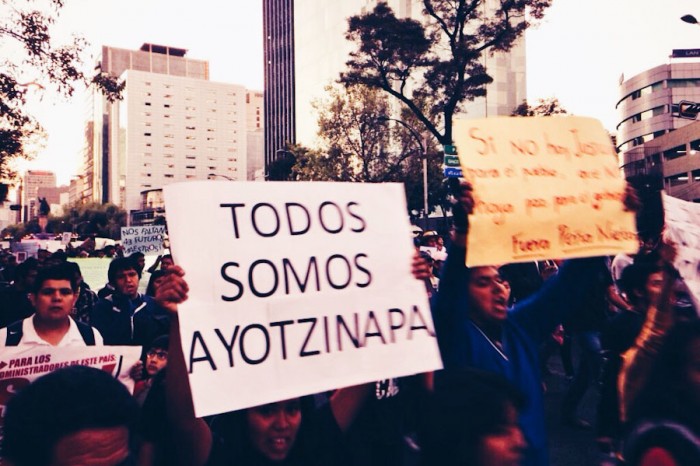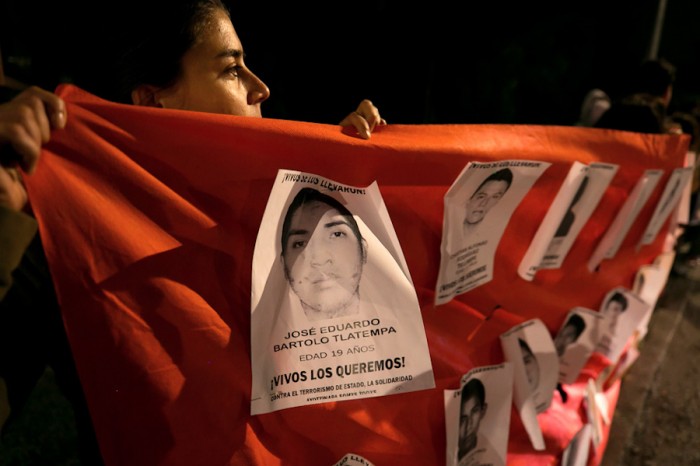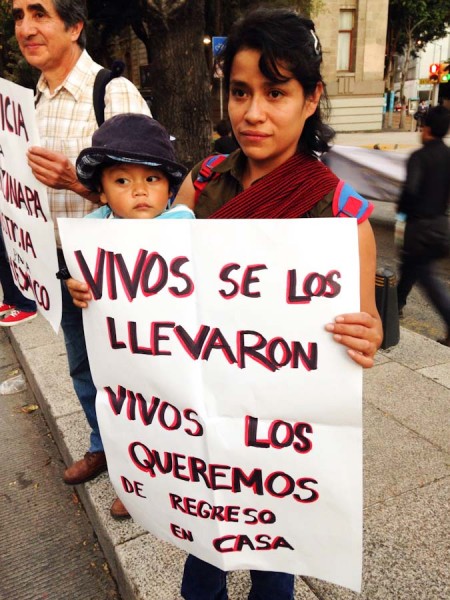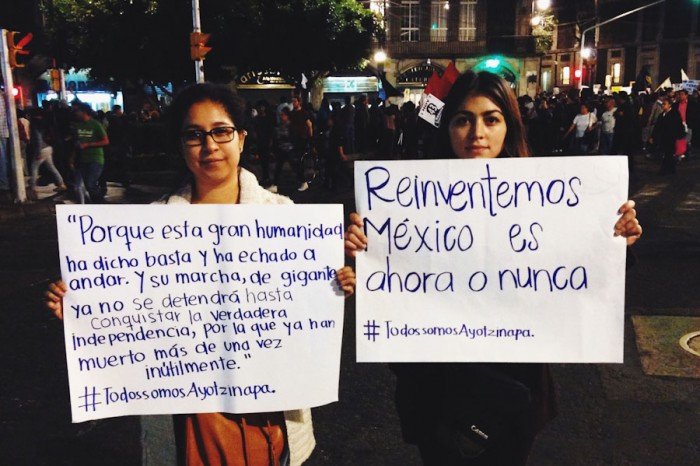
The Zócalo in Mexico City felt different on Wednesday night. The plaza was nearly packed to the edge of its colonial arches with tens of thousands of students rallying for justice for the 43 students who disappeared from Iguala, Guerrero on the eve of September 26.
Since I moved to Mexico City in September (coincidently on the eve of the 26th) a shadow of civil unrest and sadness has loomed over the capital. Alarming news headlines, graffiti on the streets, and citizen fury on social media has amplified Mexico’s desperation for justice.
Within days, my exposure to social issues and current events as a resident Chilanga became very different from the removed, romanticized understanding I had as a visitor. Instead of reading the Americas section of online U.S. papers, I was now standing in the Zócalo as an ally alongside a community affected by the reality of living in a society where government and organized crime often go hand in hand.
“It has been nearly 40 days. As parents, our children are the most sacred things we have. We will not permit that they [the government] keep betraying us,” a father addressed the crowd on a stage where the parents and siblings of the 43 stood holding posters of the faces of the missing students. The families came to the capital to tell authorities that if they did not find their children this week, they would organize a search themselves. “We will not stop fighting for our children until we’re dead.”
Ayotzinapa Normal School has been educating young men on Marxist ideals and social justice since the aftermath of the Mexican Revolution. The students are young men who come from generally poor indigenous communities around the country to be trained as teachers in rural campesino communities.
Students were reportedly organizing to block a highway to solicit funds to travel to Mexico City on October 2nd for an annual march commemorating the 1968 massacre of student protestors, when the trouble began.

Anxious that the students would wreak havoc during a speech his wife would be giving in the central plaza the next day, the mayor of Iguala José Luis Abarca ordered the police to teach them a lesson. Thehe result was the deaths of six students and the kidnapping of an additional 43 by the Guerreros Unidos, a cartel known for violence, extortion, and connections to the narcotics trade to the U.S.
After fleeing Iguala, Abarca was captured earlier this week with his wife María de los Ángeles Pineda (who has strong family ties to the Guerrero Unidos).
The case has become emblematic of the crime and violence that has plagued Mexico for decades, with corrupt police and politicians colluding with drug cartels as they outdo one another in their contempt for the lives of citizens.
“Vivos se los llevaron, Vivos los queremos” (they were taken alive, we want them back alive) has become a slogan of choice as thousands marched the Zócalo on the second “Día de Acción Global” or Global Action holding signs with the names of the 43 and carrying handmade coffins freshly painted red.
President Enrique Peña Nieto, whose platform promises economic stimulus and citizen security, met with the parents of the 43 and publicly stated that finding their children was his administration’s top priority. However for the Mexican people and the families of the 43, actions speak louder than words, and the sentiment of outrage and distrust in the Mexican government’s commitment to ending the violence is now widespread.

Authorities have been on a chaotic hunt for the remains of the students, digging up mass graves in the area and finding bodies, not of the 43, but of of 38 other victims of violence and organized crime in Guerrero.
The discoveries were another grim reminder that what happened to the students at Ayotzinapa was not an isolated incident. With the June killings of twenty-two alleged criminals in Tlatlaya by the Mexican military, the thousands of disappeared Central American and Mexican migrants passing through Mexico to the U.S., and most recent assassination of reporter Felina in Tamaulipas, Mexico has become far too familiar with state sanctioned violence and cartel impunity.
More than 29,700 forced disappearances were reported between January 2006 and July 2014. Of those, only 291 of those cases initiated investigations, and no one person has been condemned for participating in a disappearance. Only two percent of crimes in Mexico are ever prosecuted before a judge.
Michele Machado, 22-year old student at the Tecnológico de Monterrey present at the Día de Acción described the crisis of the missing 43 as “the straw that broke the camels back.”
For student Maria Saldovar Gutierrez, Mexican society is at a turning point in response to the recent waves of violence.
“Mexico has suffered from injustice and mistreatment for a long time. That is why I am here. Because it’s about changing my future, what I want and what I want for my children,” she said.
Unlike in past cases of violence in Mexico, this time the international community is watching. International organizations like Human Rights Watch are monitoring the situation and saying the government could be doing more to find the missing students. Communities around the world – Seattle included – showed their solidarity with Ayotzinapa by holding Día de Acción events in their cities and engaging on social media under #weareallayotzinapa and #todossomosayotzinapa.
“The role of the pressure that comes from the international community is fundamental,” Susana Mercado Alvarado of the City of Seattle Immigrant and Refugee Commission said in an email. “Seattle is a progressive city that has an active social justice community and is home to various organizations that do amazing work around different issues such as the ones involved with this case of Ayotzinapa. It is important to keep this case in their radar and in the mainstream media to keep the flow of information continued so the pressure from outside grows stronger and wider.”

This is not Mexico’s burden to bear alone. We share culture, community and economy with 33.5 million people of Mexican origin in the U.S. that contribute to nearly $22 billion in remittances to Mexico each year. Not to mention, as the largest consumer of drugs from organized crime, the U.S. is indirectly fueling occurrences like Ayotzinapa.
Additionally, since 2008 the U.S. has spent over $1.2 billion on security assistance for Mexico through the Merida Initiative to combat organized crime and fund programs for police training and rule of law. Addressing human rights abuses by Mexican police forces and organized crime should be a priority for the United States.
This is not only a critical moment for Mexico, but for world. We share a responsibility as global citizens to stand in solidarity with the families of the 43 and recognize the current situation in Mexico as a humanitarian crisis that our international community will not tolerate. Together, our unified response and stance against violence and impunity across borders has the influence to shape the future of democratic societies.
As thousands shouted at the Zocalo, “¡No están solos!” Ayotzinapa, you are not alone. #WeAreAllAyotzinapa

